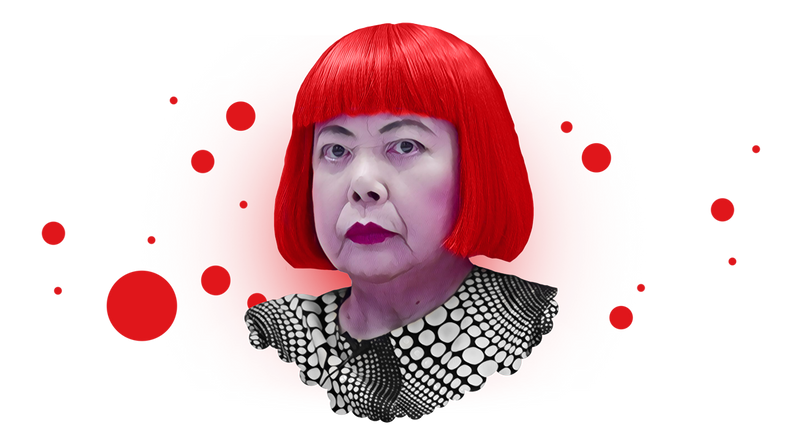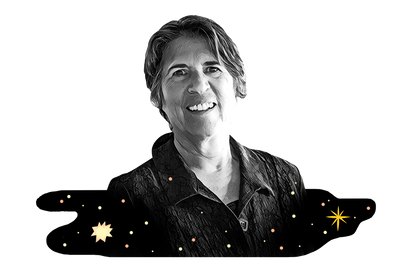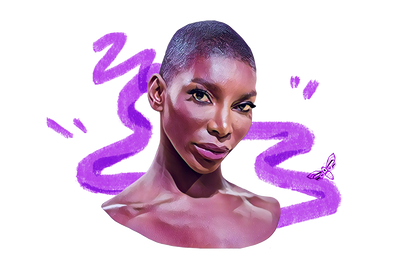This is The Order, and this is the first issue of our newsletter. The world is on fire, and nobody can put out the flame. We cannot control the future and forthcoming ordeals, but it is in our power to help ourselves cope with them. To do so, we've chosen creativity as a tool.
Each week we tell a story of one famous creator's shy first steps in the industry; offer you a practical tool to improve your art routine; share selected recommendations and ideas, and give a quick, creative warm-up at the end. Here it comes!
In today's The Order:
- Read about how the art has helped Yayoi Kusama through all the hurdles;
- Explore 16-century art game, NFT for Ukraine and digital art for Iranian women;
- Learn how to fight the fear of public speaking;
- They are minerals!
Sign up to our weekly newsletter discovering new names & opportunities and inspiring the Creators economy. It also has memes, of course.
The story of eternal struggle. How Yayoi Kusama turned her illness into art
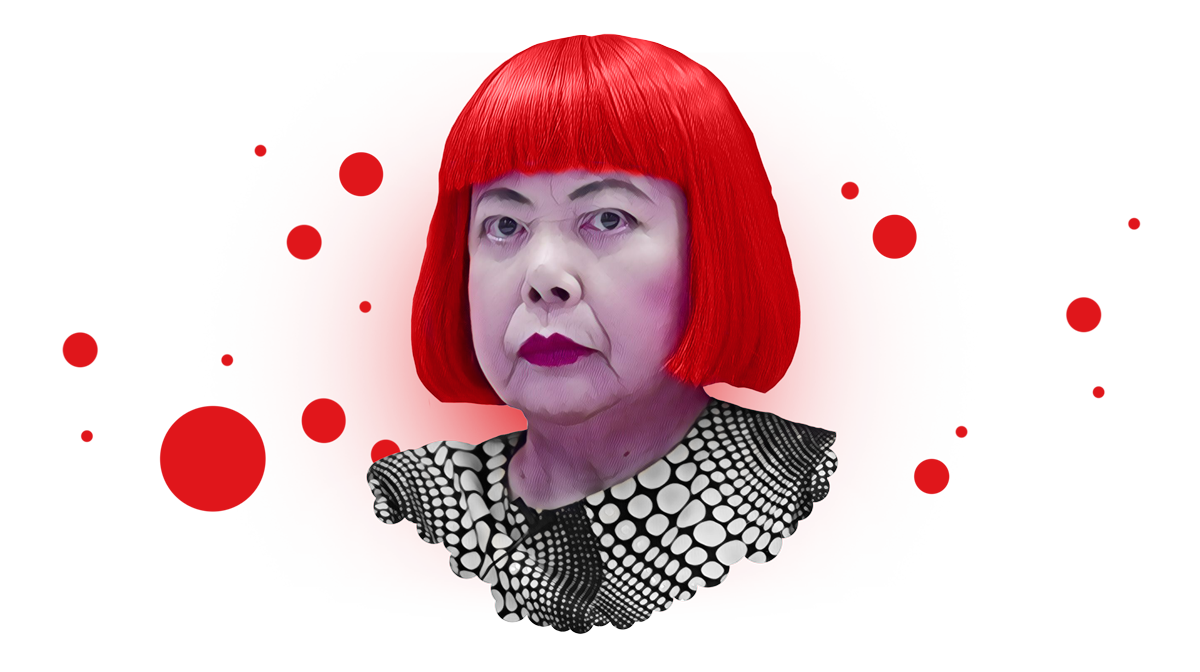
"If it wasn't for art, I would have committed suicide a long time ago," this elderly lady in a red wig likes to repeat. Yayoi Kusama is a celebrated Japanese artist who turned 93 in 2022. Her extraordinary style, bright paintings, and endless spaces covered with polka-dot drawings have become her schtick. At first glance, her paintings seem surreal. Still, for the artist, it is not a figment of the imagination but an objective reality caused by a long-standing mental disorder. As Yayoi herself says, "I struggle with pain and fear every day, and the only method that helps me cope with the disease is art."
The youngest daughter of a family from the Matsumoto mountainous region of central Japan was born in 1929. Her family made a living by cultivating plant seeds. And earned well. However, it didn't make them happy.
Her parents professed conventional Japanese values and were conservative. As a kid, Kusama used to draw a lot. Nobody taught her — it was just a childish hobby of hers. Neither was it appreciated by her family: conservatives, they planned a more universal and prosperous path for her — the girl had to marry well into a decent family and have children. Her paints were often brushed, canvases hidden and the drawings thrown out. She wasn't supposed to waste no time on unworthy occupations.
Kusama's mother had turned the whole house into her own castle. Children had to obey strict rules and were severely beaten for any misbehavior. The husband felt dominated and wasn't home a lot. The mother couldn't let it slide, so Kusama was recruited to spy on her father. Her mission was to track down the father with his mistresses. This experience was so traumatic that Kusama developed a lifelong aversion to sex.
The first hallucinations
Once, 10-years-old Kusama plucked up the courage and decided to talk to her mom. So in the evening, after dinner, she knocked on her door. "What are you doing here? Your father is home today, and I don't need you anymore." — Kusama heard.
Mother turned around and left; Yayoi Kusama remained in extreme despair, alone. Suddenly, she felt that her world had changed drastically, and she couldn't recognize a single thing around. Running in fear, trying to reach her mother, Kusama slips and rolls down the stairs. Later, the maid found her crying and lying on the ground. At the same time, she had her first attack of hallucinations.
After waking up, Yayoi Kusama thought that the "hallucination" would disappear, but it did not happen. She couldn't escape from the "spotted world," and nobody in her family believed this dimension existed. Then, by accident, she saw a pencil on the table; she grabbed it as a saving straw, and holding a pencil in her hand, she began to draw. After she vented her emotions, a gloomy and quiet little girl appeared on the paper.
Little Kusama saw flowers that spoke to her come to life, multiply, and absorb her. She calls this process of absorption "self-destruction". In her spare time, she began to draw strange pictures, drawing them one by one. These bright colors seemed to give vent to her inner pressure.
A life-changing letter
In 1948, at the age of 19, Yayoi persuades her parents to let her go to study in the Municipal School of Sciences and Arts senior class in Kyoto; there, Kusama studied the nihonga drawing style — a traditional and rather strict formal drawing school of the Meiji dynasty, which ruled in Japan from the second half of the 19th to the beginning of the 20th century.
Despite the fact that Kusama's mental state has improved, hallucination attacks have always been with her. She could not stay within the framework of traditional painting and began to work on other stylistic images. One of her favorite techniques was the active use of the "polka dot" ornament in the most unexpected ways. Kusama used this pea to cover almost every conceivable surface — walls, floors, canvases, pieces of furniture and even the naked bodies of assistants. Peans were born in her mind, she saw them in reality.
One day Kusama came to a bookstore, where she found the work of the famous American artist Georgia O'Keeffe, so-called 'mother of American modernism'. The work impressed the young girl so much that she decided to express her feelings of being oppressed in her own vision. In 1952, when she was 23 years old, Kusama showed her watercolors in a small gallery in Matsumoto. The exhibition was largely ignored and didn’t give her any recognition.
With the help of her cousin, she wrote a letter to Georgia O'Keeffe. In the letter, she described her experience in detail and expressed the hope that Georgia O'Keeffe would be able to show her a clear path. After a tense wait, Yayoi Kusama received a reply from her, in which Georgia expressed her sympathy for her experience and said, "Be brave and I will recommend you to the United States."
To escape from the "cage", she secretly went to apply for a visa to the United States behind her mother's back. The evening before she left the house, her mother called her into the room and angrily said: "You take 1 million yen and don't enter the house again." The next morning, Yayoi Kusama packed up those few things and left.
Kusama in the USA
Kusama arrived in New York in 1958, becoming one of the first post-war Japanese artists to settle in New York. But the future was not as rosy as she imagined. She did not even know English, she could not sell her paintings at all. Ultimately, she didn't have a penny in her pocket, and she could only feed herself by collecting food every day. Although the days were hard, Yayoi Kusama never thought about going back to Japan to find her mother.
During this period, she began painting her now iconic Infinity Nets series inspired by the boundless ocean. This image was especially significant for her since she grew up in an inner Japanese city. In these works, she obsessively drew small loops on a monochrome white canvas, covering the entire surface from edge to edge.
She gained real popularity in 1959 when her work was shown in The Brata Gallery and was highly praised in a review by the minimalist sculptor and critic Donald Judd, who eventually became friends with Kusama. In the mid-1960s, she established herself as an essential avant-garde artist in New York, organizing innovative and influential events and exhibitions.
Return to Japan
In 1973, due to a sharply deteriorating state of health, Kusama returned to Japan. Doctors found her with diffuse goiter and uterine fibroids. After recovering, the artist became an art dealer and started selling works by Western artists. However, the 1973 oil crisis and the subsequent recession virtually destroyed the Japanese art market, and Yayoi's career was destroyed as soon as it began.
Increasingly frustrated and depressed, she returned home to Japan, where, without the support of family or friends, and finding that she could not paint, she tried to commit suicide. But Kusama's desire to create has always been stronger than the desire to die.
Since March 1977, a woman has become a permanent resident of the Seiwa Clinic, where she was placed at her own request due to obsessive-compulsive disorder. Further on, Kusama has been living voluntarily in a psychiatric institution, and most of her work is marked by obsession and a desire to avoid psychological trauma. Trying to share her experience, she creates installations that immerse the viewer in her obsessive vision of infinite points and networks or infinitely mirrored space.
Her work gained new wide recognition in the late 1980s after many international solo exhibitions, including at the Center for International Contemporary Art in New York and the Museum of Modern Art in Oxford, both of which took place in 1989. She represented Japan in 1993 at the 45th Venice Biennale, which received critical acclaim. In 1998, the Los Angeles County Museum of Art and the Museum of Modern Art in New York jointly organized "Love Forever: Yayoi Kusama, 1958-1968.", which toured at the Walker Art Center in Minneapolis (1998-1999) and at the Museum of Modern Art in Tokyo (1999). Now the artist's works are exhibited in art galleries around the world. As Yayoi, herself says, "I struggle with pain and fear every day, and the only method that helps me cope with the disease is art."
New names, projects, possibilities
🎮 Fixing murders and drawing simultaneuosly in new manuscript-based console game.
🇺🇦 Saving Ukrainian cultural heritage through NFT.
🔥 Digital poster of Women, Life, Freedom in Iranian protests
💰 A grant to support the production of new artistic work by emerging artists and to contribute to the professional advancement of those artists
How to distinguish fear from fobia and succeed in public speaking
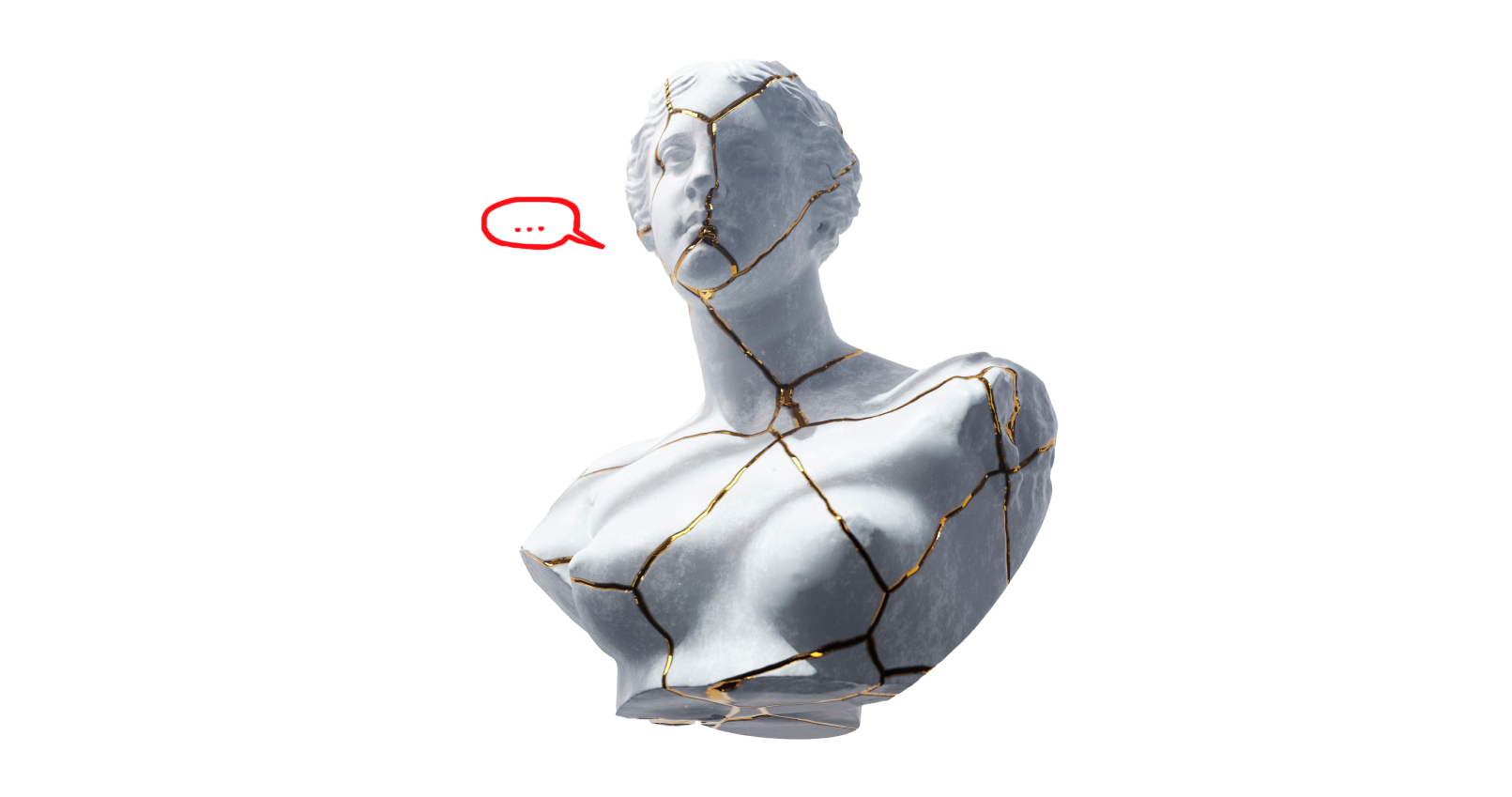
Public speaking is an activity — quite uncomfortable for most — we get to perform in various places and situations. Whether you're hosting a standup, participating in a daily business meeting or opening your own exhibition, a fear of public speaking could be waiting for you around any corner. And it's quite a complex fear: it could combine an impostor syndrome, anxiety, feeling of imminent failure and many others. So the main question is — how do we fight it right before we have to give a speech? Here are a few advices from The Order:
1. Prepare beforehand
Besides obvious advice to study your material beforehand, we suggest exploring the place you'll be presenting at. Try conducting an imaginary rehearsal in the room: walk around it, stand on the stage, and think of a mic. If your speech is online, ensure your background is fine and gives you confidence.
And if you believe in superstition, it's not the time to be ashamed of it. Can a coin in your boot help? Don't hesitate and put it there. It's okay to give into anxiety and become less rational than you really are. Go ahead, and enter the room with your left foot. Perhaps, it would really help your meeting go smoother.
2. Bring yourself back to your body
Anxiety makes us lose the feeling of our body and its connection to the surroundings. So, when the pre-speech panic kicks in, try to pause and observe the space around you. For example, you can try counting all the bald heads in the room. Or, list 4 sounds you can hear, 3 items you can see, 2 smells and 1 taste you can feel. It will help you get back into your body.
3. Stop looking at the audience
While presenting, focus on some random abstract point right in the middle of the room, slightly above people's heads, or concentrate your attention on one particular person. Looking at all people at once and analyzing their reactions will only worsen the anxiety.
4. Disperse the blood
When we are nervous, blood drains from the arms and legs to the center of the corp. This mechanism prepares our body for a fight and an attack. So, to reduce fear, you can disperse the blood to the limbs. In this sense, online presentations are good again - no one sees your arms and legs. You can turn the handle, massage the brushes, or roll a tennis ball under the table.
If the performance takes place in the hall, there are still options. You can walk around the stage, sorting through the memo cards or material in your hands.
5. Don't forget to breathe
When we worry, we feel that time passes faster. But, in fact, it isn't. Therefore, nothing terrible will happen if you pause for just a sec, take a slow deep breath and let it out. The audience won't even notice the hitch. A tiny pause might even make the speech more drematic.
Meme of the week for the patient ones
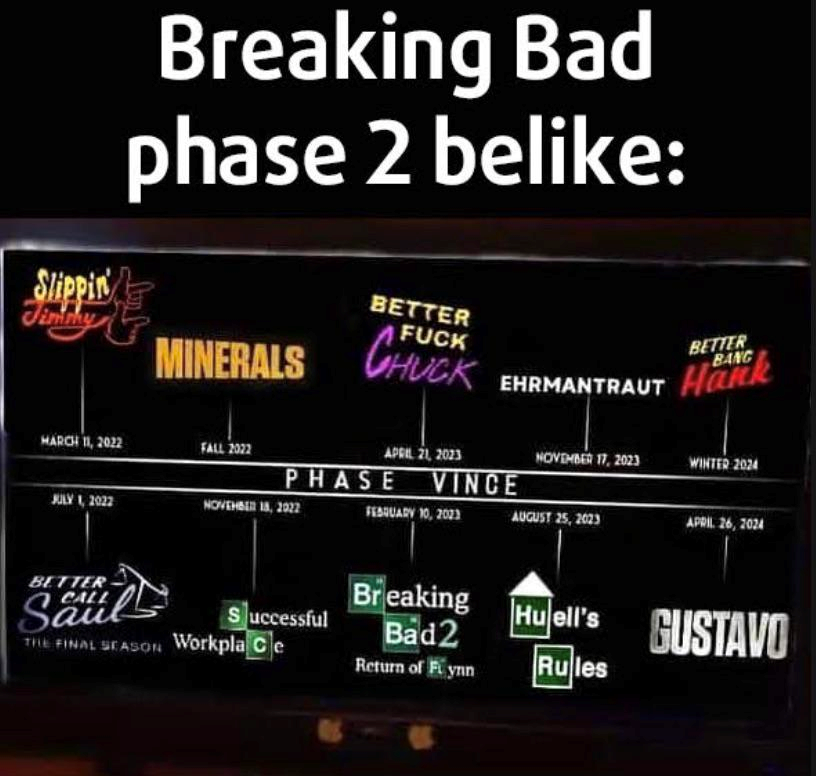
Creative warm-up
Set a timer for 10 minutes. Take a paper and a pen — or just open your digital notes.
Write a short emotional story. You can use only nouns. Topic Diversity. You can send it to us and get feedback, or keep it to yourself, or share with friends — as you wish.
Today's newsletter is brought by Alexey Shumkin, Artem Shur, Mariya Amrayeva, Alyona Belyakova, Egor Mostovshikov
Your creative self starts in your inbox
Sign up to our weekly newsletter discovering new names & opportunities and inspiring the Creators economy. It also has memes, of course.

